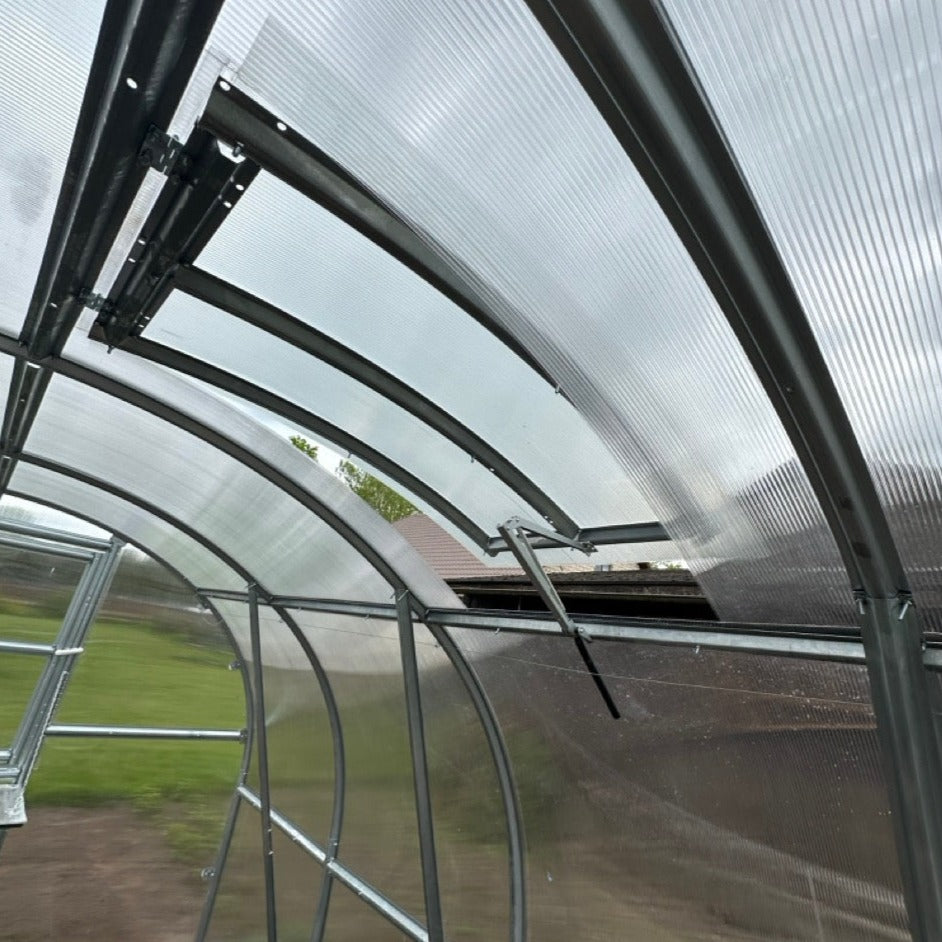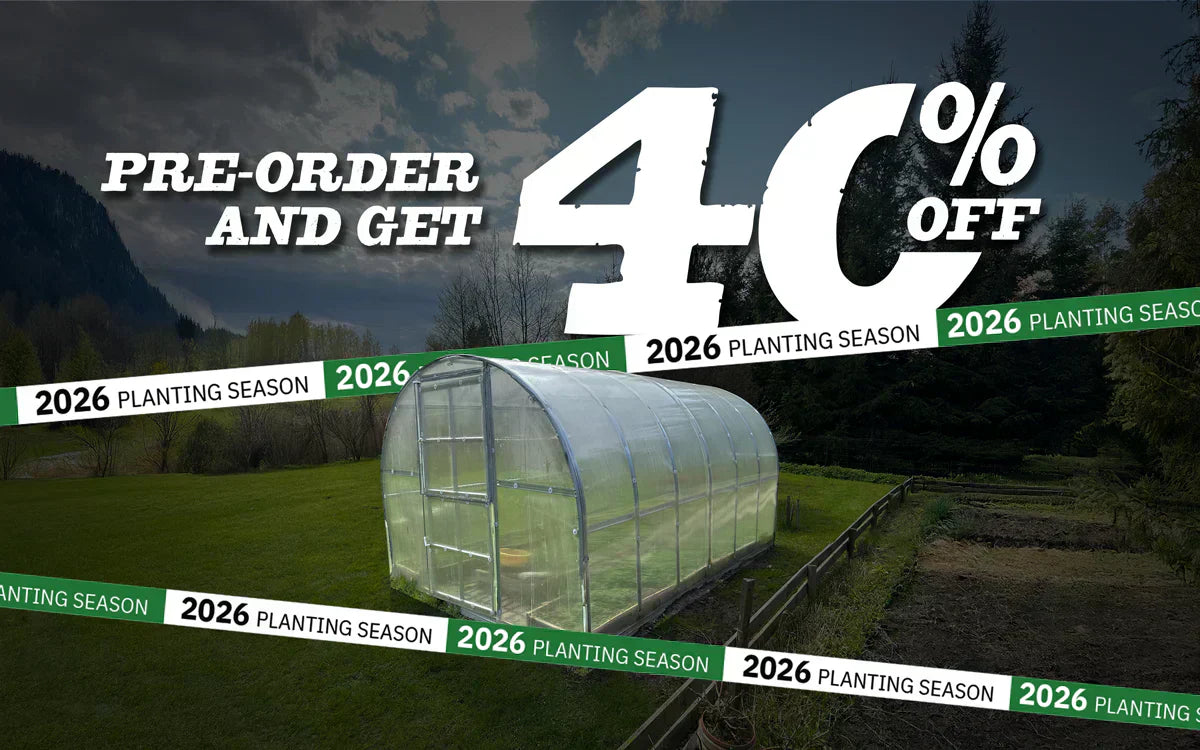How to Grow Strawberries in a Greenhouse: A Comprehensive Guide
Growing strawberries in a greenhouse is a great way to enjoy fresh, juicy berries year-round. On top of that, homegrown strawberries are a hundred times tastier and juicier than store-bought strawberries.
The biggest catch, however, is providing the right conditions for your strawberries. You see, growing strawberries doesn’t entail a lot of work, but if you need to produce a bountiful and healthy harvest of strawberries, you need to provide them with the right conditions and care.
And in this guide, we’ll share exactly that. In our strawberry growing guide, we will explore the best practices for growing strawberries in a greenhouse.
Our guide shall touch on some crucial aspects such as temperature, humidity, and lighting conditions. We shall also focus on how to select the right soil, fertilization, and irrigation system.
Read on!
Understanding the Greenhouse Environment
When it comes to growing strawberries in a greenhouse, understanding the environment is crucial. While a greenhouse allows gardeners to take control it's up to the gardener to ensure the conditions are optimal for the plants.
In this section, we will take a closer look at how we can manipulate light, temperature, and humidity, in ways that kind of make you a gardening god.
Temperature Control
Maintaining the correct temperature is essential for the growth of strawberry plants. The ideal temperature for strawberries is between 60-80°F. Temperatures outside this range can result in the growth of leaves and runners (stolons) or stunted growth.
The good thing about growing strawberries in a greenhouse is you can control the temperatures with a heating or cooling system. Your strawberries benefit from the greenhouse-controlled environment for maximum output.
Humidity Management
Maintaining the proper relative humidity is critical for growing strawberries. To achieve the maximum yield, good fruit size, and tasty fruit, you must set the relative humidity at 65 to 80%-this is considered the optimum humidity for strawberry production.
Low humidity affects calcium uptake in strawberries, causing tip burn, ultimately affecting photosynthesis and fruit quality, while high humidity can lead to fungal diseases.
A greenhouse should have a humidifier and dehumidifier to maintain the ideal humidity level. A humidifier can be used to increase humidity levels, while a dehumidifier can be used to decrease humidity levels.
Lighting Conditions

While strawberries are native to temperate regions and prefer cool climates, they need full sun to produce maximum fruit. Generally, strawberries will thrive when exposed to at least 8-10 hours of sunlight per day.
If you can’t achieve that in your location, you can use supplemental lighting for the extra light. LED grow lights are an excellent option for greenhouse lighting. They are energy-efficient and provide the right spectrum of light for plant growth. When using LED grow lights, it's essential to position them correctly to ensure that all plants receive adequate light.
In conclusion, understanding the greenhouse environment is crucial for growing strawberries in a greenhouse. Temperature control, humidity management, and lighting conditions are all essential factors that must be taken into consideration.
By maintaining optimal conditions, gardeners can ensure that their strawberry plants grow healthy and produce a bountiful harvest.
Preparing for Strawberry Cultivation
Now that we’ve discussed the greenhouse environment and the major elements to consider, let’s look at how to prepare for strawberry cultivation.
Selecting Strawberry Varieties
Strawberries come in different varieties, and when selecting the ideal variety for your greenhouse, you need to consider factors such as yield, flavor, disease resistance, and ripening time. The variety for your greenhouse, however, depends on your specific growing conditions and goals.
Here are some of the best strawberry varieties to consider for greenhouse growing:
June-Bearing Strawberries
June-bearing strawberries are the most popular type of strawberry and produce a large crop in early summer. They are known for their large fruit size and excellent flavor. Some of the best June-bearing strawberry varieties for greenhouse growing include:
- Chandler: This variety is known for its large, sweet fruit and high yield. It is a good choice for greenhouse growers who want to sell their strawberries commercially.
- Jewel: Jewel is a popular variety that produces large, firm fruit with a bright red color. It is resistant to many common strawberry diseases.
- Seascape: Seascape is a newer variety that is known for its high yield and disease resistance. It produces large, sweet fruit throughout the growing season.
Ever-Bearing Strawberries
Ever-bearing strawberries produce fruit throughout the growing season, with the heaviest production in the spring and fall.
They are a good choice for greenhouse growers who want a steady supply of strawberries throughout the year.
Some of the best ever-bearing strawberry varieties for greenhouse growing include:
- Albion: Albion is a popular ever-bearing variety that produces large, firm fruit with a sweet flavor. It is known for its disease resistance and high yield.
- Quinault: Quinault is a good choice for greenhouse growers who want a compact plant that produces a large crop of sweet, juicy fruit.
- Tribute: Tribute is a newer ever-bearing variety that is known for its high yield and excellent flavor. It produces fruit throughout the growing season.
Day-Neutral Strawberries
Day-neutral strawberries produce fruit throughout the growing season, regardless of day length. They are a good choice for greenhouse growers who want a steady supply of strawberries year-round.
Some of the best day-neutral strawberry varieties for greenhouse growing include:
- Evie-2: Evie-2 is a popular day-neutral variety that produces large, sweet fruit throughout the growing season. It is known for its disease resistance and high yield.
- Fern: Fern is a newer day-neutral variety that is known for its high yield and excellent flavor. It produces fruit throughout the growing season and is resistant to many common strawberry diseases.
- Seascape: Seascape is a day-neutral variety that is also a good choice for greenhouse growers. It produces large, sweet fruit throughout the growing season and is resistant to many common strawberry diseases.
Overall, the best strawberry varieties for greenhouse growing will depend on your specific growing conditions and goals. Consider factors such as fruit size, flavor, disease resistance, and yield when choosing the best variety for your greenhouse.
Soil Preparation and Fertilization
Soil preparation is important for the growth and development of strawberries. Generally, strawberries thrive in well-draining soil and with rich organic matter.
You must also consider the soil’s pH level. The ideal soil pH level for the optimal growth and cultivation of strawberries is 5.5 to 6.5. It’s also important that you regularly test the soil to ensure that the pH and nutrient levels are optimal for strawberry growth.
Adding organic matter to the soil can improve soil structure and nutrient availability. In particular, fertilization is also important for healthy plant growth and fruit production. A balanced fertilizer with equal parts nitrogen, phosphorus, and potassium can be applied before planting, and then again every four to six weeks during the growing season.
Planting Containers and Spacing
An ideal way to grow strawberries in a greenhouse is in raised beds, containers, or hanging baskets for optimal space use.
Whichever method you use, ensure your strawberries are properly spaced and that there’s enough drainage. Generally, the spacing between individual plants should be about 12 to 18 inches, depending on the variety of strawberry.
Proper spacing is necessary for air circulation and prevention of overcrowding, which can lead to diseases and reduced yields. You must also ensure that the crown (where the roots meet the stem) is at the soil level.
Planting and Maintenance
Transplanting Seedlings

Transplanting the strawberry seedlings is a delicate operation, and it requires utmost care. For starters, you should only transplant healthy plants, with strong roots. The best time to transplant is in the early spring, after the last frost.
Before transplanting, ensure that your soil is well-drained and enriched with compost. The seedlings should be spaced about 12 inches apart and planted at the same depth as they were in their original containers.
Ensure you water the seedlings immediately after transplanting to help them establish their roots.
Watering Techniques
Strawberries require consistent moisture to thrive, and therefore, the plants should be watered regularly. However, overwatering strawberries can be harmful and can result in root rot.
Our recommendation to avoid overwatering is to use the drip irrigation method. Another benefit of this method is that it delivers water straight to the roots, and avoids getting water on the leaves, which can promote fungal diseases.
Pest and Disease Management
Strawberry plants are susceptible to a variety of pests and diseases, including aphids, spider mites, and powdery mildew.
To prevent pest infestation, consider inspecting your plants regularly for signs of damage or disease. If pests or diseases are detected, treat your plants immediately with an appropriate pesticide or fungicide.
It is also important to maintain good hygiene in the greenhouse, keeping the area clean and free of debris that can harbor pests and diseases.
Harvesting and Post-Harvest Care
Picking the Strawberries
Timing is important when picking greenhouse strawberries for harvesting. Ideally, you should only pick them when they’re fully ripe, and this is usually when they are bright red and firm to the touch.
It is also best to pick strawberries in the morning when the fruit is cool and the sugar content is at its highest.
To pick the strawberries, gently grasp the stem just above the fruit and pull it off the plant. Be careful not to damage the fruit or the plant. It is recommended to pick the fruit every two to three days to ensure that it is harvested at the right time and to prevent over-ripening.
Storage and Preservation
After harvesting your strawberries, store them in a cool, dry place. Don’t wash them until they’re about to be consumed. Washing strawberries too early can cause them to soften and spoil too early.
The best way to preserve greenhouse strawberries is to freeze or can them. When freezing strawberries, remove the stems and wash the fruit thoroughly. Dry the strawberries and place them in a single layer on a baking sheet. Freeze the strawberries for several hours before transferring them to a freezer bag or container.
When canning strawberries, it is important to follow proper canning procedures to ensure safety and quality. The strawberries should be washed, hulled, and packed into jars with sweet syrup. The jars should then be processed in a boiling water bath for the recommended time based on the altitude and size of the jars.
Frequently Asked Questions
Can I Grow Strawberries in a Greenhouse All Year-Round?
Yes, you can grow strawberries in a greenhouse all year round, but it takes a bit of planning and equipment.
For example, it requires you to set up the ideal greenhouse environment and control the essential environmental factors such as lighting conditions, temperature, and humidity.
Can I Grow Strawberries in a Greenhouse During the Winter Session?
Yes, you can grow strawberries in a greenhouse during the winter season. However, it's important to provide supplemental heating and lighting to ensure optimal growth and fruit production.
What Are the Common Mistakes to Avoid When Growing Strawberries in a Greenhouse?
Some common mistakes to avoid when growing strawberries in a greenhouse include overwatering, using poor-quality soil or growing medium, not providing adequate ventilation, and not monitoring the plants for pests and diseases.
Conclusion: Strawberry Cultivation in Greenhouses
Growing strawberries in a greenhouse is a great way to enjoy delicious fruits all year round, in the comfort of your backyard garden.
But for you to enjoy a continuous harvest of delicious strawberries from your greenhouse, you must follow our guidelines.
Keep in mind that specific practices may vary based on your local climate and the strawberry varieties you choose. Regular monitoring and adjustments to the growing conditions will contribute to a successful strawberry harvest.












